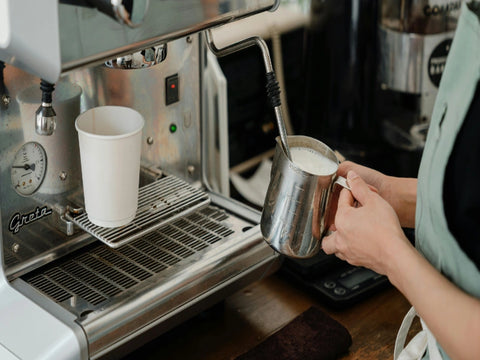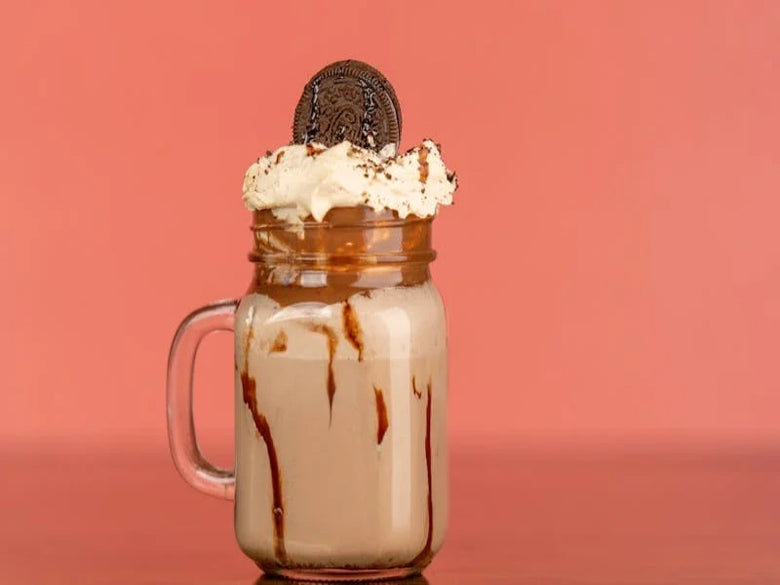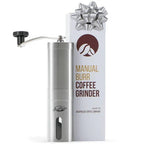Are you a coffee lover looking to beat the heat this summer? In the battle of beverages, the latte and frappe are two popular contenders that offer a refreshing and creamy indulgence.
We will explore the key differences between latte and frappe, from ingredients to preparation methods and nutritional content.
Come with us as we dive into the world of these chilled delights to help you decide which one is cooler for you.
What Are Latte and Frappe?
Latte and frappe are both beloved coffee beverages that offer a delightful combination of flavors and textures, perfect for indulging in a refreshing drink during the summer season.
Originating from Italy, latte, meaning ‘milk’ in Italian, consists of espresso blended with steamed milk, creating a creamy and slightly sweet beverage. It is often enjoyed as a morning pick-me-up or afternoon treat, and its versatility allows for various flavor additions like vanilla or caramel.
On the other hand, the frappe, originating from Greece, is a chilled coffee drink blended with ice and milk, offering a cool and frothy texture. Its popularity lies in its ability to be customized with syrup flavors and toppings, making it a favorite summer indulgence.
What Are the Differences Between Latte and Frappe?

Latte and frappe may both be coffee-based beverages, but they differ significantly in terms of temperature, texture, taste, and ingredients, providing diverse options for coffee enthusiasts based on their preferences.
A latte is typically prepared by pouring espresso into steamed milk, creating a creamy and smooth beverage served hot or iced. The key ingredients in a latte are espresso, milk, and sometimes a hint of foam. This method gives lattes a rich and velvety texture, with a balanced taste that showcases the espresso.
On the other hand, a frappe involves blending espresso, milk, ice, and sugar or flavorings, resulting in a cold and refreshing drink with a thicker consistency and a more intense coffee flavor.
Ingredients
The ingredients used in latte and frappe play a crucial role in defining their distinct tastes and textures, with latte typically featuring a combination of espresso, steamed milk, and a touch of creamy foam, while frappe often incorporates chilled espresso or coffee, milk, and sweeteners for a refreshing and customizable treat.
In a latte, the richness of the espresso is balanced by the velvety smoothness of steamed milk, creating a harmonious blend of bold coffee flavor and creamy sweetness. The creamy foam topping adds a light, airy texture that enhances the overall drinking experience.
On the other hand, a frappe delights with its cool and creamy consistency, where the chilled espresso or coffee pairs perfectly with milk, offering a frothy refreshment that can be personalized with various flavors and sweeteners. Milk serves as the base that binds all elements together, adding a subtle sweetness and creaminess to both beverages.
Texture and Consistency
The texture and consistency of latte and frappe offer contrasting experiences, with latte known for its velvety smoothness and creamy mouthfeel achieved through the steamed milk and espresso blend, while frappe delights with its icy, frothy, and blended texture that appeals to those seeking a more refreshing and indulgent option.
In the realm of latte preparation, the artful infusion of frothy milk with a shot of concentrated espresso creates a luxurious creamy layer that lingers on the palate, providing a harmonious balance between rich flavors and a silky feel.
On the other hand, a frappe's textural charm lies in the dance of blended ice, milk, and flavored syrups, resulting in a lighter, airier mouthfeel that is often paired with whimsical toppings and swirls of whipped cream for added delight.
Consumers often gravitate towards either the creamy sophistication of a latte or the playful, frothy allure of a frappe based on their preference for the comforting familiarity of a warm, velvety beverage or the invigorating chill of a blended concoction."
Serving Style
The serving styles of latte and frappe add to the overall experience, with latte often presented in a classic cup or glass, showcasing the layers of espresso and milk, while frappe comes in a trendy clear cup or special container, garnished with whipped cream, straws, and other decorative elements that enhance the visual appeal and enjoyment of the beverage.
This attention to detail in presentation is not just about aesthetics but also about creating an experience that stands out. Latte art, with intricate designs created by skilled baristas using steamed milk, adds a touch of artistry to the drink.
On the other hand, frappes are often topped with colorful drizzles, cookie crumbs, or sprinkles, making them not only delicious but also visually appealing for social media posts. These unique touches not only make these beverages a treat for the taste buds but also a feast for the eyes, turning a simple drink into an Instagrammable moment.
Nutritional Content
Understanding the nutritional content of latte and frappe is essential for making informed choices, with latte typically containing varying amounts of calories, sugar, and dairy components, while frappe variants offer options for those seeking lower-calorie alternatives or dairy-free versions for a potentially healthier treat.
When it comes to calorie content, a typical latte can range from around 100 to 400 calories, depending on the size and any additional syrups or toppings. In contrast, frappes tend to be higher in calories due to the added sugar and creamier base, often landing between 300 to 600 calories.
Read: How Many Calories Are In Coffee? (Black Coffee, Lattes, And Beyond)
For those looking to watch their sugar intake, latte options can also vary greatly, with some specialty flavors containing significant amounts of added sugars. Frappes generally tend to contain more sugar to enhance their sweet and indulgent flavors.
Those seeking dairy-free alternatives will find that both lattes and frappes can be made with plant-based milks such as almond, oat, or soy, providing options for those with lactose intolerance or following a vegan diet.
It's important to be mindful of ingredient choices when ordering these beverages to align with individual health goals and preferences.
Which One is Healthier?

Determining which between latte and frappe is healthier involves considering various factors such as their sugar content, caffeine levels, and fat content, allowing consumers to make a choice based on their personal preferences and dietary requirements.
When it comes to sugar content, lattes generally contain less sugar compared to frappes, especially if they are unsweetened or made with sugar-free syrups. For individuals looking to reduce their sugar intake, opting for a latte might be a better choice.
In terms of caffeine levels, frappes tend to have higher concentrations due to the added espresso shots or coffee, making them a go-to option for those seeking a more significant caffeine boost.
The fat content in these beverages differs with lattes often being lower in fat compared to creamier frappes, which may appeal to individuals aiming for a lighter option.
The nutritional value of each drink can impact how they are perceived in terms of being healthier, with latte being viewed as a simpler, less calorific option while frappes are often seen as a treat or indulgence due to their higher sugar and fat content.
Sugar Content
The sugar content in latte and frappe influences their overall taste profiles, with latte often offering a balanced sweetness from the milk and espresso combination, while frappe may vary in sweetness levels depending on the added syrups or flavorings, providing contrasting taste experiences for those with different preferences.The level of sweetness in these beverages can significantly impact how consumers perceive their flavor. Latte, being more subdued in sweetness, tends to appeal to those who prefer a milder taste profile with hints of bitterness from the espresso.
On the other hand, frappes, especially those loaded with sugary syrups, cater to individuals who enjoy a more pronounced sweetness that can sometimes mask the coffee flavor. This dichotomy in sweetness levels reflects the ongoing debate among consumers regarding the ideal balance between sweet and bitter notes in their coffee drinks.
Caffeine Content
The caffeine content in latte and frappe offers varying levels of energy boost, with latte typically containing espresso shots that provide a concentrated caffeine kick, while frappe may feature cold brew coffee for a smoother and potentially lower caffeine experience, catering to individuals with different caffeine sensitivities and preferences.
Espresso shots are renowned for their immediate impact on energy levels due to the high concentration of caffeine, making them a popular choice for those seeking a quick pick-me-up.
Cold brew coffee, on the other hand, offers a milder caffeine release, gently boosting energy over a longer period, making it a preferable option for individuals looking for sustained alertness.
These differences in caffeine effects influence consumer choices, with some opting for the intense burst from espresso shots, while others prefer the gradual uplift from cold brew coffee.
Read: Why You Need To Drink Coffee Black
Fat Content
The fat content in latte and frappe varies based on the use of cream, dairy components, and potential dairy-free alternatives, allowing individuals to opt for a higher-fat, indulgent treat or choose a lower-fat, potentially healthier option that aligns with their dietary needs and preferences.
- Cream plays a significant role in adding richness to these beverages, contributing to their velvety texture and mouthfeel.
- For those seeking a lighter option, opting for skim milk or plant-based milk alternatives like almond or oat milk can reduce the overall fat content while still providing a satisfying drink.
- Consumer preferences for fat content can vary widely, with some enjoying the creamy indulgence of a full-fat latte or frappe, while others prefer the lighter, less-caloric version for a guilt-free indulgence.
How Are They Made?

The preparation of latte and frappe involves skilled baristas creating these delightful beverages using specialized equipment such as espresso machines, milk frothers, and whipped cream dispensers, showcasing the artistry and expertise that goes into crafting these beloved coffee drinks.
Baristas begin the process by carefully selecting the best quality coffee beans, as the foundation of a perfect latte or frappe lies in the quality of the espresso. Once the beans are chosen, they are ground to the ideal consistency before being tamped into the portafilter. The espresso machine then comes into play, extracting the rich and aromatic espresso shot which forms the base of these beverages. The milk frother is used to steam and froth the milk to velvety perfection, blending it with the espresso shot to create the signature creamy texture that defines a latte or frappe.
Latte Preparation
The meticulous preparation of a latte involves a skilled barista expertly pulling shots of espresso, steaming milk to a velvety texture, and carefully layering the espresso and milk to create a harmonious blend that delights the senses with its rich aroma and creamy finish.As the barista begins the process, they first grind freshly roasted coffee beans to ensure the perfect extraction for the espresso shots. The quality of the grind directly impacts the flavor profile of the coffee.
Once the espresso has been pulled, the barista moves on to frothing the milk, creating a silky microfoam that adds a luxurious texture to the latte. By incorporating the steamed milk with the espresso in a precise manner, the barista achieves the iconic layers that make a latte visually appealing and satisfying to sip.
Frappe Preparation
Creating a delightful frappe involves baristas skillfully blending chilled espresso or coffee with ice, sweeteners, and milk to achieve a smooth and creamy consistency, often topping the beverage with whipped cream for added indulgence and serving it chilled to enhance the refreshing and satisfying qualities of this trendy drink.
The blending technique is crucial in ensuring that all the ingredients harmoniously come together, resulting in a luscious and well-balanced flavor profile that captivates the taste buds. By carefully blending the mixture until it reaches the perfect texture, the baristas achieve a drink that is not only visually appealing but also irresistibly velvety on the palate.
This meticulous preparation process highlights the dedication and artistry that goes into crafting each frappe, making it a must-have indulgence for those seeking a cool and invigorating beverage during warm summer days.
What Are the Popular Flavors of Latte and Frappe?
Latte and frappe offer an array of popular flavors that cater to diverse taste preferences, with latte presenting classic choices like vanilla, caramel, and hazelnut, while frappe entices with indulgent options such as mocha, caramel, and seasonal fruit flavors, allowing coffee lovers to enjoy a customized and flavorful experience.
The significance of having such a variety of flavors available in both latte and frappe lies in the ability to cater to different preferences and moods. From the comforting familiarity of a vanilla latte to the boldness of a mocha frappe, these beverages allow for a personalized touch.
Seasonal offerings add an element of excitement and novelty, with flavors like peppermint or pumpkin spice bringing a seasonal flair. Customization options further elevate the sensory experience, as customers can adjust sweetness levels, add extra flavor shots, or choose alternative milk options for a truly tailored drink.
Read: 5 Must Try Coffee Recipes for a Perfect Girls Brunch
Latte Flavors

Latte enthusiasts can savor a variety of classic flavors such as vanilla, caramel, and hazelnut, each offering a distinct taste profile that enhances the rich espresso and creamy milk base, providing choices for customization and personalization based on individual preferences.
Vanilla, with its subtle sweetness, adds a comforting note to the latte, balancing the boldness of the espresso perfectly.
Caramel brings a rich, buttery undertone that complements the coffee's bitterness, creating a harmonious blend of flavors.
Meanwhile, hazelnut infuses a nutty essence, adding a delightful depth to the drink.
The ability to mix and match these flavors allows for endless possibilities, catering to a wide range of palates and preferences.
Such diverse choices elevate the latte experience, making each sip a unique and tailored delight.
Frappe Flavors
Frappe aficionados can delight in an assortment of indulgent flavors such as mocha, caramel, and seasonal fruit variations, each offering a refreshing and satisfying taste experience that caters to diverse preferences and seasonal cravings, showcasing the versatility and appeal of this trendy coffee beverage.
From classic mocha for those who enjoy a rich chocolatey kick to creamy caramel for those with a sweet tooth, frappes cater to a wide range of taste buds. Seasonal fruit options bring a burst of freshness to the mix, offering a unique and vibrant flavor profile that changes with the time of year. The allure of experimenting with different flavor combinations, whether it's a comforting winter spice or a refreshing summer fruit blend, adds to the excitement of indulging in these innovative and satisfying frappe varieties.
Which One is More Popular?
Determining the popularity between latte and frappe involves considering consumer preferences, seasonal trends, and the evolving coffee culture that influences the choice between these beloved beverages, showcasing how both options have garnered significant followings among coffee enthusiasts seeking diverse and trendy choices.
Latte, with its smooth and creamy texture, appeals to those who prefer a more traditional coffee experience, often opting for its comforting blend of espresso and steamed milk.
On the other hand, the frappe's icy and refreshing qualities make it a go-to choice during hot summer months, satisfying cravings for a chilled caffeine fix.
The customization options for both drinks, from flavor syrups to varied milk choices, cater to the individual tastes of consumers, reflecting the versatility and personalization that define modern coffee culture.
Which One Should You Choose?

Choosing between latte and frappe comes down to personal preference, desired indulgence level, and taste preferences, inviting consumers to explore both options through taste tests or sampling to determine which beverage aligns best with their flavor expectations, lifestyle choices, and summer beverage cravings.
Consider your taste for creamy, frothy textures and espresso strength - a latte is a classic choice for those who enjoy a balance of rich coffee flavor with velvety milk.
On the other hand, if you prefer a colder, blended treat with a variety of flavors and toppings, a frappe might be more appealing.
Understanding your daily routines and habits can also play a part; a latte is often savored in peaceful moments, while a frappe makes for a fun, on-the-go refreshment.
By exploring these factors and trying both options, you can discover the ideal drink for your beverage desires.


